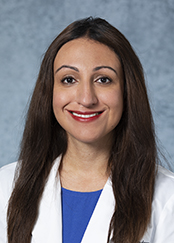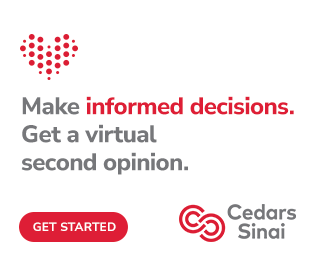Cedars-Sinai Blog
New Headache Clinic Aims to Expand Possibilities for Patients
Apr 11, 2022 Cedars-Sinai Staff

Headache is the leading reason patients seek a neurologist.
"Nearly everyone will have a headache at some point in their life," said Nasima Diana Shadbehr, DO, "and headache disorders are a leading cause of disability."
The World Health Organization estimates nearly half of the global adult population experiences at least one headache annually, but only a minority of people suffering from headache disorders receive adequate diagnosis and treatment.

Nasima D. Shadbehr, DO
To further complicate matters, headaches can fluctuate throughout a person's life, and patients' reactions to therapies can vary over time. Understanding headaches and triggers and finding medication that fits the patient's lifestyle can be challenging.
"Patients are best served when they have someone with dedicated time to devote to getting to the bottom of the headache diagnosis. We want to understand what treatments they have tried, what has failed and what could come next."
"Patients may use too much over-the-counter medication or overuse prescribed treatments," Shadbehr said. "This can worsen the condition and trigger rebound headaches."
To meet ever-growing patient needs, Cedars-Sinai is creating a dedicated headache clinic.
The value of specialized expertise
Specialists with dedicated training in headache and facial pain are leading the way in the new headache clinic, using a multidisciplinary approach involving collaboration across neurosurgery, psychiatry, psychology and pain management.
Typically, physicians are trained to identify three types of headaches: migraines, tension headaches and cluster headaches. But subspecialists trained in refractory and facial pain can dig deeper to investigate the patient's condition. They work to map the triggers, onset, frequency and experience of headaches, unlocking more than 400 headache types, causes and diagnoses.
Shadbehr, a board-certified neurologist and headache specialist, envisions offering novel therapies and integrating new research to provide expanded opportunities for patients. She aims to increase involvement in and availability of clinical trials, in part through the establishment and growth of residency and fellowship programs, ultimately giving more patients more opportunity to access the latest in innovative research and advancing the academic growth of the field.
More than anything else, Shadbehr says headache treatment requires building a trusting therapeutic relationship based in listening. Subspecialists are then uniquely equipped with a detailed understanding of existing treatment options, emerging therapies and new research underway.
"Patients are best served when they have someone with dedicated time to devote to getting to the bottom of the headache diagnosis," said Shadbehr. "We want to understand what treatments they have tried, what has failed and what could come next."
In the blog: New Treatment Options for Headaches
Emerging headache therapies
Researchers have long sought to understand the physiological processes within the body that result in headache. Early therapeutic options include preventive medications that seek to avoid the occurrence of headache, abortive treatments meant to get rid of headache pain, and rescue therapies that work to lessen pain and symptoms if other methods fail.
For example, today triptans are widely used as an abortive treatment for migraine or cluster headaches to target the serotonin receptors on blood vessels in the brain and cause the blood vessels to narrow. However, this is not a preventive treatment and is not suitable for many patients.
Botulinum toxin injections are also approved for treatment of chronic migraines in adults and are believed to be effective by blocking neurotransmitters associated with pain, interrupting the pain pathway.
Physicians at Cedars-Sinai are looking to the future for new and better ways to help headache patients. Newer therapies reflect an evolving understanding of the science of headache. During the past two years alone, several new headache medications emerged, with more research underway for additional treatment modalities.
Calcitonin Gene-Related Peptide
Calcitonin gene-related peptide (CGRP) is a molecule that is directly implicated in migraine pathophysiology in pain. As CGRP attaches to its receptor, pain and inflammation can occur, resulting in migraine. Recent advancements in therapies employ molecules targeted to disrupt the process.
Early results show promise for some patients who have not had success from other treatments or cannot tolerate the side effects associated with triptans, as well as for patients with significant cardiac or cerebrovascular risk factors.
Some of these therapies employ small molecules called gepants, which block the CGRP receptor. Currently, these can be used for migraine prevention (rimegepant, atogepant) or for acute migraine treatment (ubrogepant, rimegepant).
Other therapies employ larger, humanized monoclonal antibodies that block the CGRP pathway for migraine prevention. Erenumab binds to the CGRP receptor while galcanezumab and fremanezumab bind to the CGRP ligand and block it from binding to its receptor. These therapies are offered as subcutaneous injections received monthly (erenumab, galcanezumab, fremanezumab) or quarterly (fremanezumab).
There is also a quarterly IV infusion therapy called eptinezumab that can be offered if patients do not respond to the injectable treatments.
Ditans
Another newer medication called lasmiditan acts as a selective serotonin receptor agonist and is used in treating migraines. It targets and activates 5-HT1F receptors found on nerves located in the brain and skull. It is believed that this process blocks pain signals, stopping migraine attack. The medication works similarly to existing triptans with regard to serotonin receptors but without triggering the side effects associated with narrowing the blood vessels.
Neuromodulation
Noninvasive neuromodulation devices offer a medication-free option to treat headache disorders. It is thought that the stimulation they provide may manipulate pain processing. These wearable devices employ a magnetic or electrical pulse and are controlled via a phone or handheld tool.
Hope on the horizon
Shadbehr expects the trajectory of rapid growth in the field to continue as scientists and physicians evaluate how to combine new and existing therapies to expand treatment options for patients.
"All of these devices and treatments have some Food and Drug Administration approvals for certain indications, but there is a lot of room for exploring and expanding the utilization of various treatment options," said Shadbehr.
Growing the research program within the headache clinic at Cedars-Sinai could make therapies available to patients who otherwise would have struggled to access new, much-needed options.
"It's important we don't let those who are experiencing debilitating headaches lose hope," said Shadbehr. "We just need to find the right combination of medications and treatment modalities."


